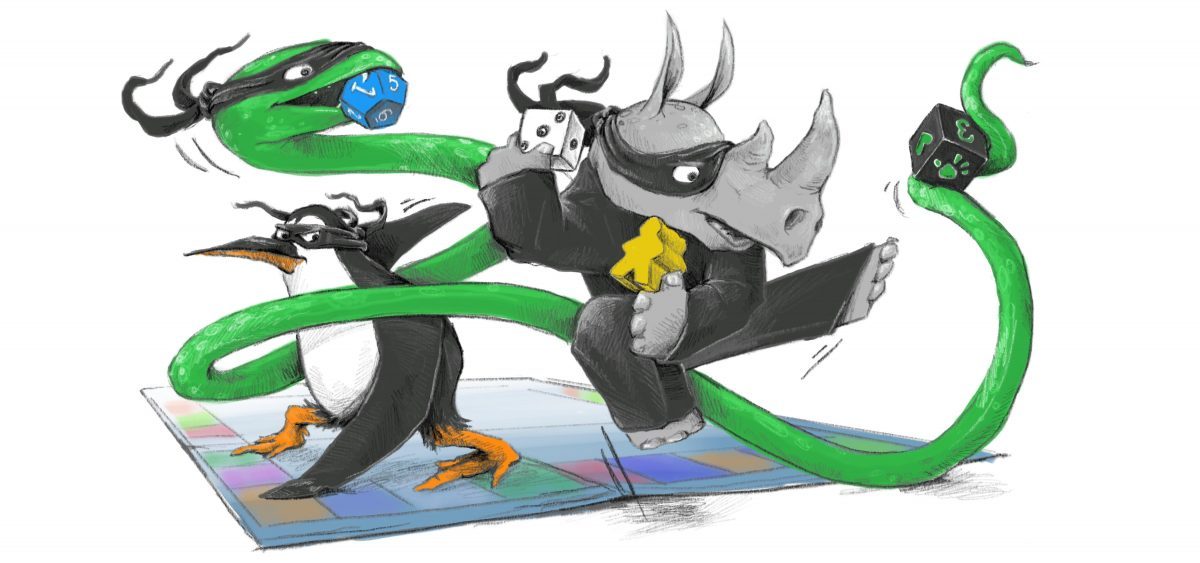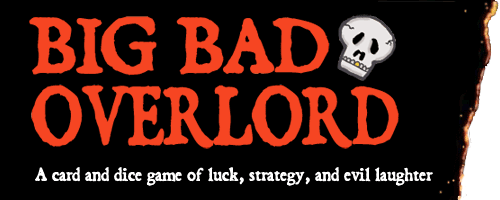Big Bad Overlord is a game of Battles for 4-6 players in which you will be trying to defeat other Dukes in an attempt to reign supreme. You will be teaming up to attack and defend, but mostly just in an attempt to screw your buddy. Once you take out someone’s Army, you have to attack their Citadel and finally their Duke. Last one standing wins.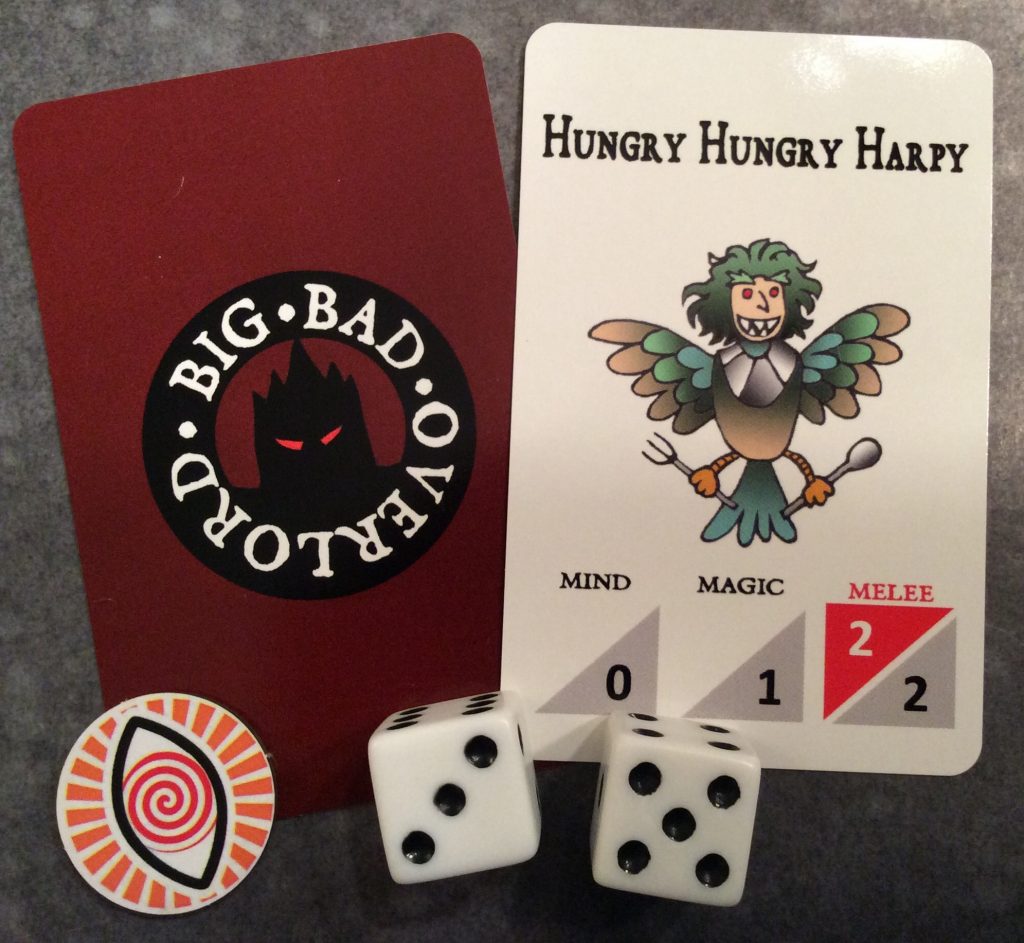 Let’s look at the gameplay:
Let’s look at the gameplay:
Big Bad Overlord is mostly made up of cards. Each Duke has a playmat, and there are Dice and Mind Control markers, but the cards are what really matter. So let’s look at those.
At the start of the game, everyone gets 6 cards. 3 go into your Army, 3 into your Citadel. You can exchange these at the beginning and end of your turn, but not in the middle of your turn or the middle of a battle. If your Army is defeated, you defend with the forces in your Citadel. If you Citadel is defeated, you still have your Duke. If your Duke is defeated…..well, nice knowing you.
Each card has a funny/witty name, a silly illustration and 3 important stats at the bottom, Mind, Magic and Melee. These are the stats that will determine who wins the battles.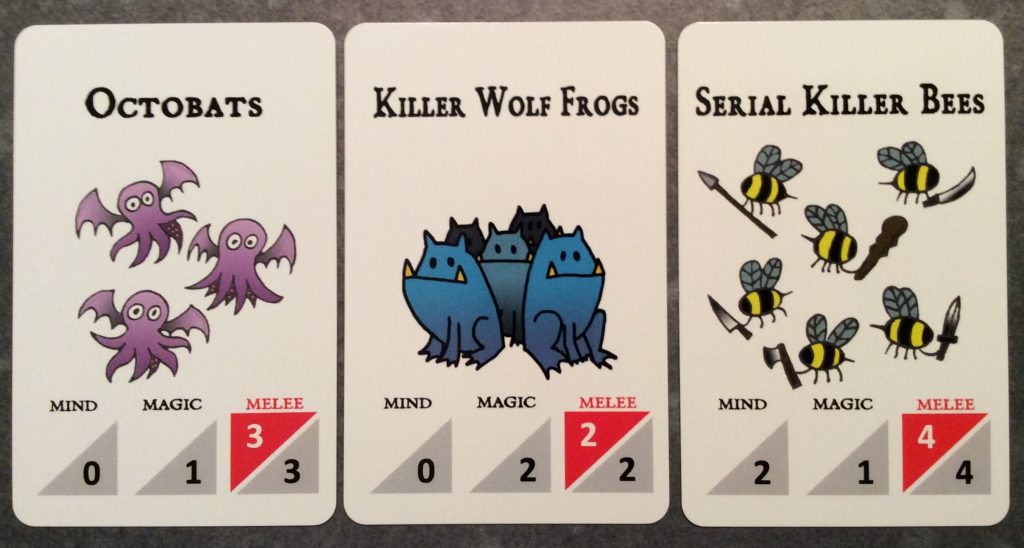 Basically any stats listed in a Red triangle are modifiers to your attacks. Don’t have any Red triangles in that stat? Then you can’t use that type of magic. Example: Killer Wolf Frogs only have a Red stat in Melee, so if you are only attacking with Killer Wolf Frogs you cannot use Mind or Magic attacks. They do have a defense in those categories though, just in case they are attacked by someone who does have that kind of attack.
Basically any stats listed in a Red triangle are modifiers to your attacks. Don’t have any Red triangles in that stat? Then you can’t use that type of magic. Example: Killer Wolf Frogs only have a Red stat in Melee, so if you are only attacking with Killer Wolf Frogs you cannot use Mind or Magic attacks. They do have a defense in those categories though, just in case they are attacked by someone who does have that kind of attack.
When you go on the offensive, you add up the stats in Red for that attack type and this becomes the modifier that you add to your dice roll. Say you are using the Frogs and the Knights of Darkness.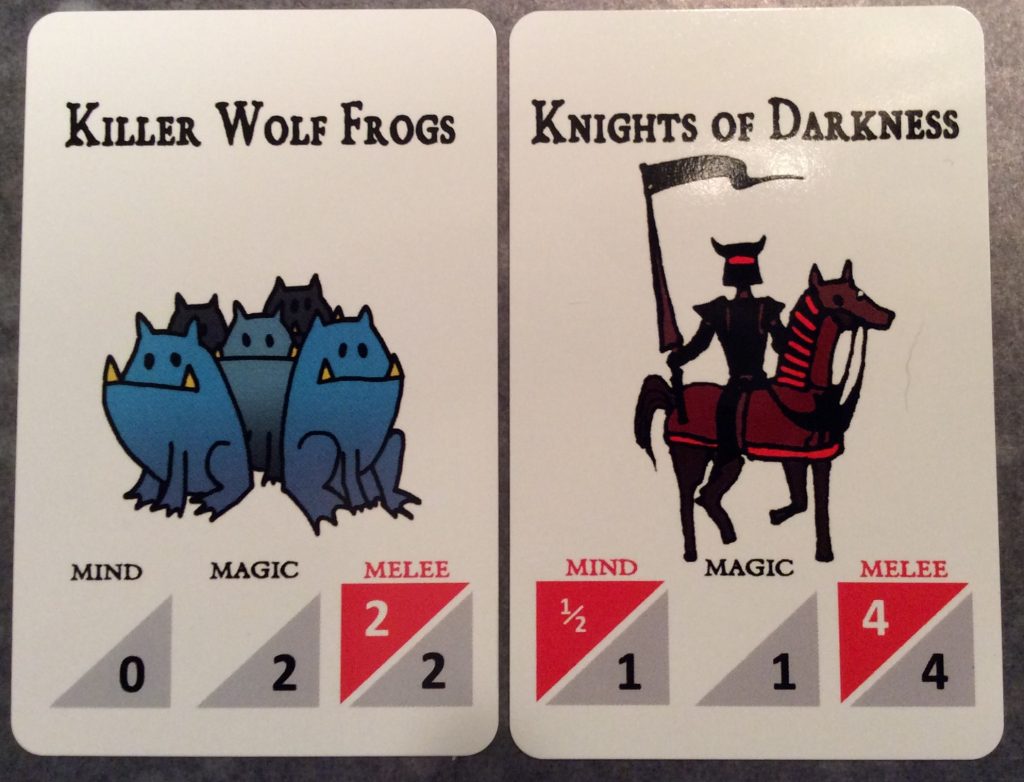 Your Melee modifier will be a +6. If you roll a 3, your attack is now a 9. Your opponent also adds there Red stats to their roll. Whoever’s final number is higher wins, and the loser must discard their card with the lowest Melee defense (the number in the Gray triangle).
Your Melee modifier will be a +6. If you roll a 3, your attack is now a 9. Your opponent also adds there Red stats to their roll. Whoever’s final number is higher wins, and the loser must discard their card with the lowest Melee defense (the number in the Gray triangle).
Melee is the simplest part of the Battle, but happens last. First you must resolve Mind and Magic attacks. Mind and Magic attacks also add up the Red numbers to modify your dice roll, but your goal is to roll a 12.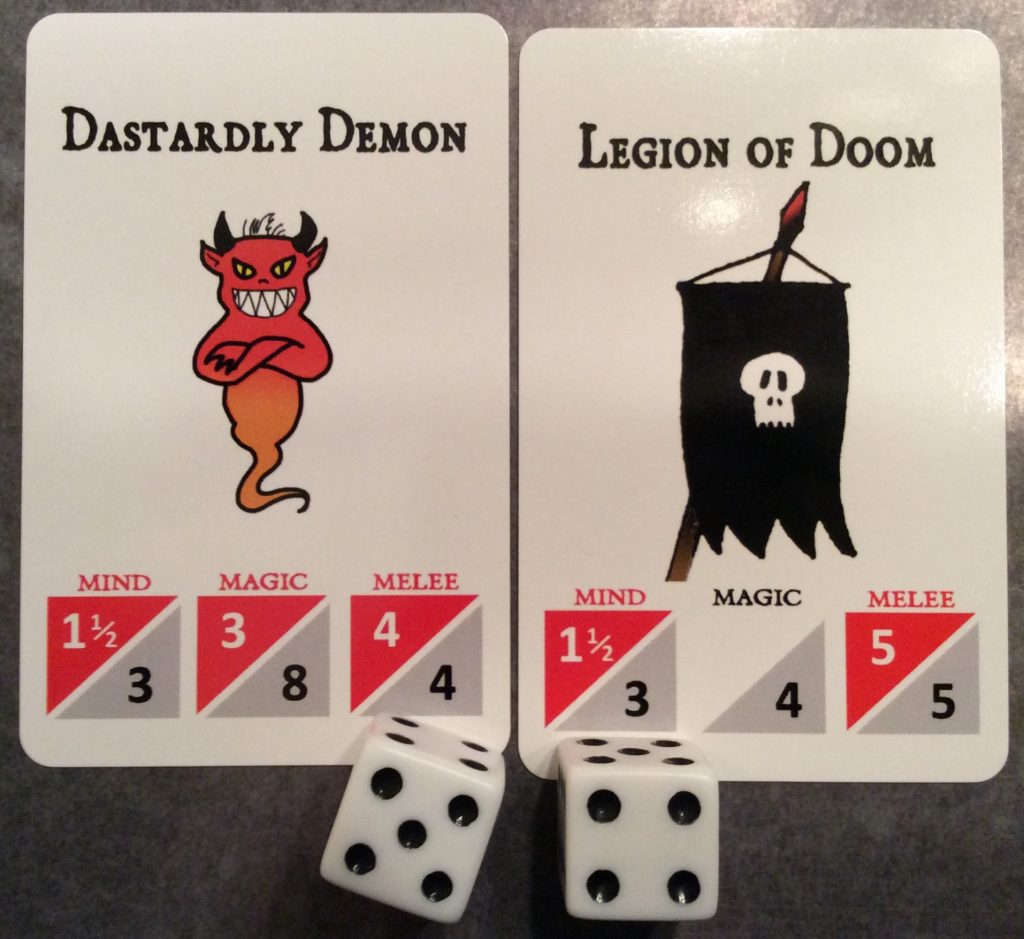
So if your modifier is +3 and you roll a 9, your attack succeeds. If you roll under a 12, it does not. Also Mind often have 1/2 or 1 1/2 modifiers. You always round down.
Successful Mind attacks allow you to take control of one of your opponents cards for the round. Successful Magic attacks defeat the card with the lowest magic defense.
If at any time during any kind of attack you roll a natural 12, your attack succeeds/you win, no matter what the modifiers would’ve had to say about it. If you roll a natural 2, your attack fails/you lose no matter what.
The cards differ in strength and usefulness. There are cards like the Machine of Death, the Horrible Monster, and the Champion of Evil that give you a significant advantage once you draw them.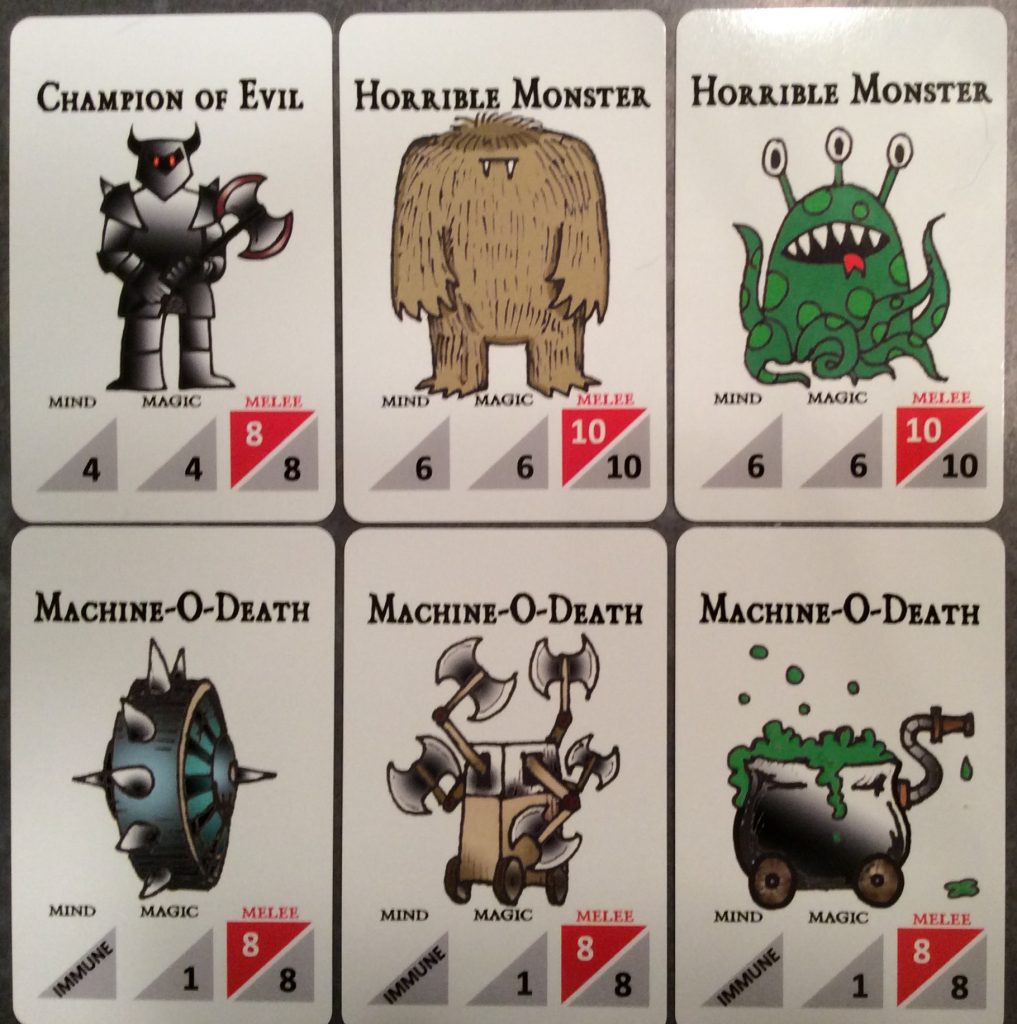 After I got one of these, I always felt it was time to go on the offensive. Or I could’ve decided to put one in my Citadel and feel really well defended. Then there are cards like Lickspittle and Toady who are basically just cannon fodder.
After I got one of these, I always felt it was time to go on the offensive. Or I could’ve decided to put one in my Citadel and feel really well defended. Then there are cards like Lickspittle and Toady who are basically just cannon fodder.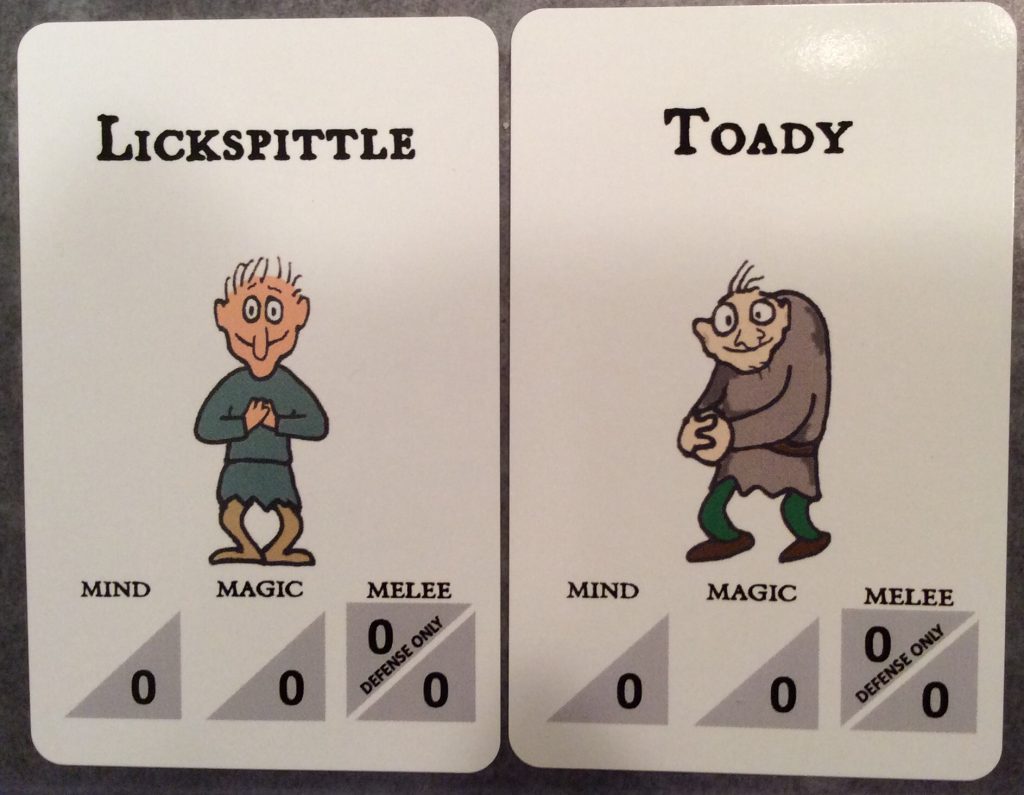
The attacks are the major part of the game, but attacking all the time can leave your Army or Citadel vulnerable. You’ll find yourself having to make interesting choice like: Brad just got attacked, do I let him build back up? or should I attack Miller who had been quietly building up his hand for 3 turns? Do I go on the offensive right away or is it best to try to build up my army? And if I do build up, isn’t everyone going to?
So what’s to prevent everyone from just building up a huge Army before acting at all?
Well, first, there’s impatience. When people start ganging up on each other, it tends to whittle down the cards in their Army more so than it does in the Citadel of the person being attacked. So if someone spends their turn attacking, they are often vulnerable on the next turn.
But also 2 other things. First off there’s a timer. If you run out of cards in the deck, you start the Cataclysm. This is an immediate Sudden Death battle between 2 of the Dukes. I say 2 because only the 2 Dukes who possess 1 of the Artifacts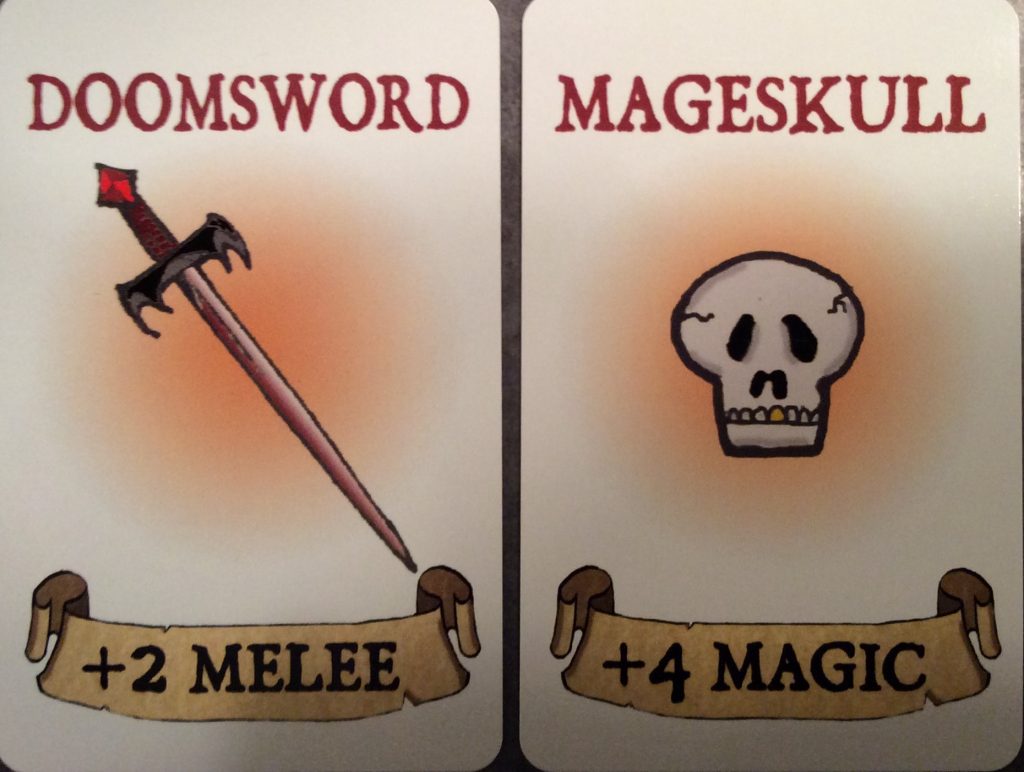 (the Mageskull or the Doomsword) survive the Cataclysm long enough to battle it out. All other players are immediately eliminated. If one player has both of the Artifacts when the cards run out, they are declared the winner. Period.
(the Mageskull or the Doomsword) survive the Cataclysm long enough to battle it out. All other players are immediately eliminated. If one player has both of the Artifacts when the cards run out, they are declared the winner. Period.
The other thing that prevents the build up are Do-Gooders. Ten times during the game (which is about once per round), someone will also have to face a Do-Gooder that comes out to play. 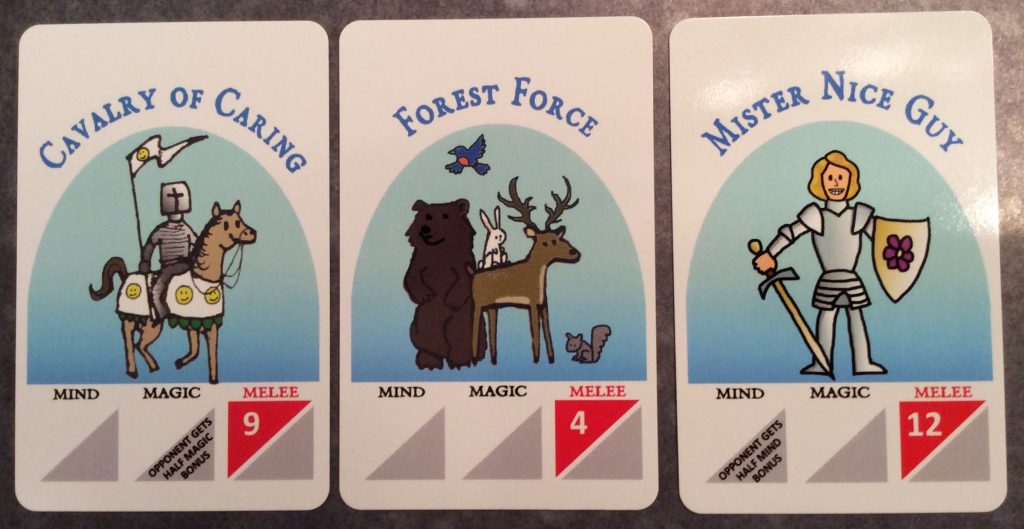 These characters and creatures work against everything you and your fellow Overlords are trying to accomplish. They attack which ever player drew their card, and will not stop until completely defeated, even if they wipe out an Overlord’s Duke. They will simply move on to the next player. Plus if they manage to use Mind control to steal a creature away from you, that creature continues to fight for them until they are defeated as well.
These characters and creatures work against everything you and your fellow Overlords are trying to accomplish. They attack which ever player drew their card, and will not stop until completely defeated, even if they wipe out an Overlord’s Duke. They will simply move on to the next player. Plus if they manage to use Mind control to steal a creature away from you, that creature continues to fight for them until they are defeated as well.
Also, it’s really not easy to completely defeat someone. When you have defeated their Army and are attacking their Citadel, their forces Attack bonuses are doubled, and yours are halved. This makes a huge difference, and usually keeps players alive longer than you would think. Thus the Hour playtime.
So…Thoughts?
First let’s hear the Good News: Big Bad Overlord has a lot going for it. Changing loyalties and backstabbing are ever present. Very often you will be attacking the player that just helped you the last turn. When you see an opening you take it, and more times than not, you will probably pay the price immediately. But how else are you to become the Big Bad Overlord.
I really liked the gameplay for the most part. It has a very Munchkin like feel to it, in that you will be helping each other out, either to attack or defend, and it really feels like the designers were definitely going after the Munchkin crowd. Unlike Munchkin, however, I didn’t feel limited as to how many times I could act per turn. As long as you have cards in your Army, you don’t have to stop after you finished attacking once. If I see that Bob helped me in my attack against Brad and lost 2 cards doing it, I might (in the same turn) attack Bob. I mean, he is more vulnerable now, plus I can stop after I defeat his one remaining card. I don’t have to go up against his Citadel.
The artwork also reemphasizes the attempt at a Munchkin like game. The art is fantastically silly. It is cartoony and goofy in the best way, and the first thing that drew me to the game. I love it.
Now don’t let this talk of Munchkin-ness turn you off, or make you think that I didn’t like the game because of that. Munchkin is not really my game. To me, it goes on way too long. Big Bad Overlord takes the best parts of Munchkin and adds its own twist to make it much more concise and, to me, fun.
So, is there any Bad News?: Well, there are a couple of things that troubled me just a bit, but not enough to keep me away.
First is the Luck factor. It is HUGE. The cards you get to defend your Citadel and make up your Army are the definition of Luck of the Draw. If someone starts off with 6 fantastic cards, the will gain a significant advantage right off the bat. Then there is the constant dice rolling. Anyone who knows me know that Dice are not my friends, so I was constantly losing battles that I thought I had a really good chance at winning. And win it comes down to attacking someone’s Duke, there are often no modifiers at all, just my dice against yours. And I am very unlucky. But I got past that because the game is just stinkin’ fun.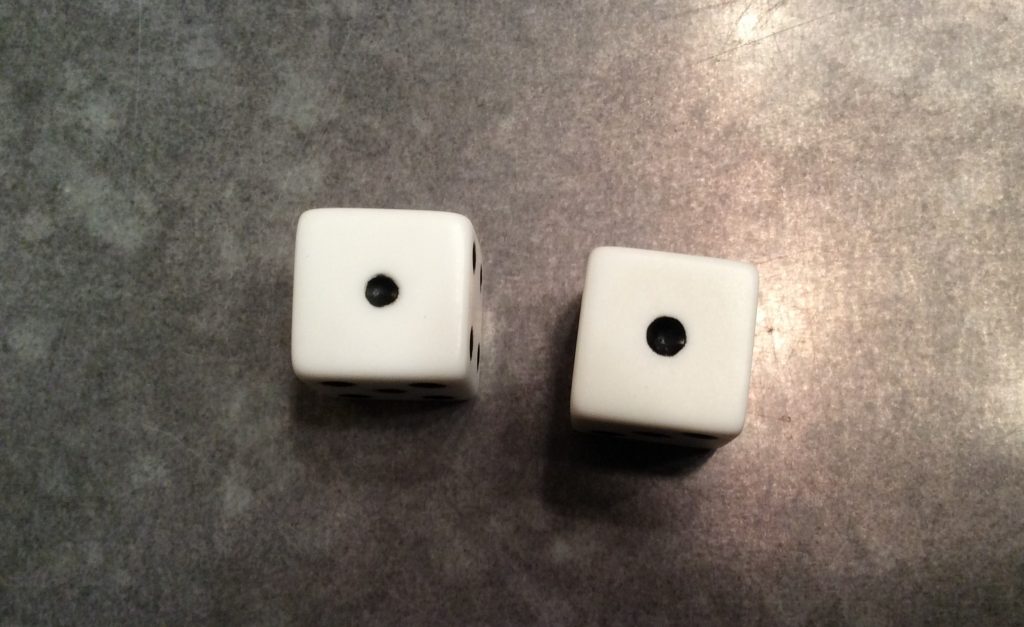
The second thing that troubled me was the Timing mechanism built into the game. If you run out of cards and the Cataclysm begins you can simply be out of the game. This can sometimes cause the “Why did I even play this game for the last hour?” reaction. It’s a very efficient way to make sure the game doesn’t go on forever, but doesn’t feel very fair when you are one of the ones eliminated. I wish there was a way to do an all out free-for-all battle instead. I don’t know how that would work, but at least I wouldn’t feel cheated. But the solution we found to this was to keep attacking, don’t run out of cards.
There is also the possibility that one player will feel as though they are constantly being Ganged Up on. That is because it is not only allowed, but encouraged. There is even a part in the rules called Ganging Up. So, if you have someone in your group that doesn’t like this type of thing, they are not going to have a good time, but since I know my group, I know when to bring this one out.
Overall, I think this is a really solid game. The rules are a little much to grasp if you are just reading them, but if someone is walking you through them, you will catch on very quickly. There are tons of different strategies to employ. Depending on which way your luck is going, you can try to immediately attack someone right out of the gate, or try to build up your Army for an all out offensive (if your opponents let you build up). Your loyalties will change almost every turn, and you will be questioning your opponents’ intentions constantly.
The gameplay is fun and interesting and the art gives it enough of a cutesy factor to offset some of the evil. Some.
The perfect recipe for a backstabbing good time. Ninja Approved.
